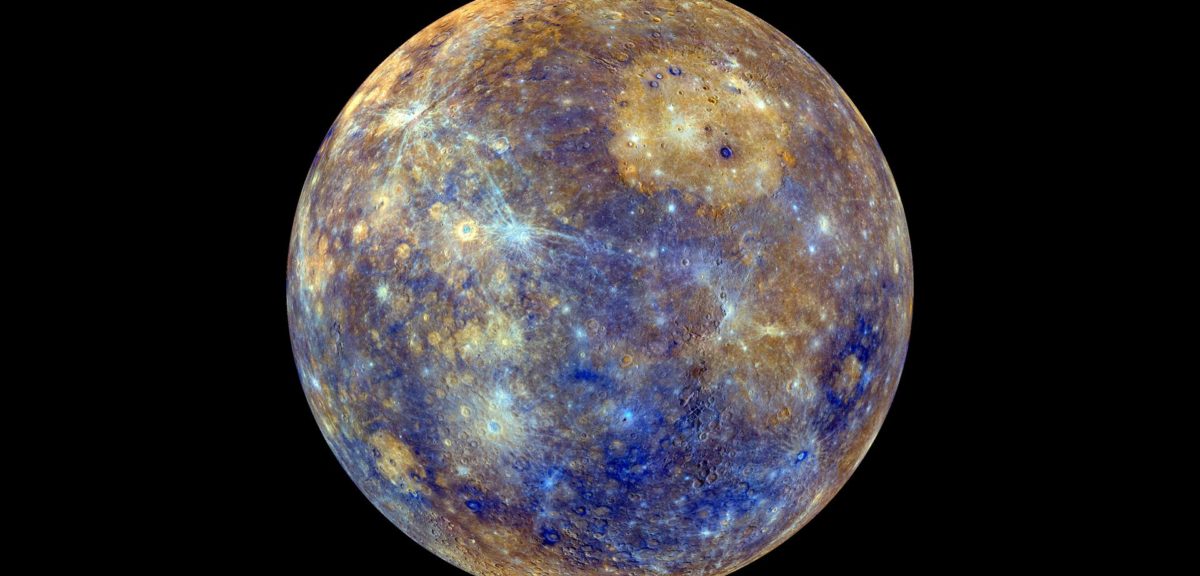
Mercury from image data by NASA’s MESSENGER spacecraft. (NASA/JHU Applied Physics Lab/Carnegie Inst)
A first glance, the planet Mercury looks a lot like our Moon, both gray and pockmarked with craters after being bombarded with meteorites and blasted by the solar wind over the millennia. Some take the similarity further, referring to them as “twins.”
The color of Mercury’s surface though is much darker than the moon, so much so that scientists consider it to be the least reflective of all the planets in our solar system. It’s nearest neighboring planet, Venus, on the other hand, is considered the brightest and most reflective of our planetary neighbors.
Now a group of scientists say that new research they’ve conducted may have solved the long-standing mystery of Mercury’s dark, dull finish.
Writing in the latest edition of the journal, Nature Geoscience, the scientists said their studies suggest that a steady dusting of carbon released by passing comets over billions of years has slowly painted Mercury’s surface black.
“Our study answers a longstanding mystery about why Mercury’s surface is darker than the moon’s surface, by implicating carbon as a “stealth” darkening agent, which is difficult to detect with available remote sensing methods,” said lead author Megan Bruck Syal, a postdoctoral researcher at Lawrence Livermore National Laboratory in a press release. “Mercury is effectively painted black by the constant influx of carbon-rich micrometeorites.”

Impact material generated without the presence of carbon from complex organics, top left, is lighter than material generated with carbon, top right. Scanning electron microscope images, bottom row, show finer-scale structure and texture variations. Images: (NASA/Ames/Brown University)
Since comets often break apart as they get close to the sun, Mercury a mere 57,910,000 km away, receives a steady barrage of cometary dust, which is about 25 percent carbon by weight, from these crumbling celestial bodies.
So, the researchers developed and used a computer model to estimate just how much of the cometary dust that hit Mercury actually stuck to the planet’s surface versus the amount that bounced back into space.
Calculations made from the model suggested that Mercury’s surface should be between 3 to 6 percent carbon after billions of years collecting cometary dust.
The researchers then needed to determine just how dark Mercury’s surface would be after being coated by so much cometary carbon over such a long period of time.
Using a 4 meter cannon at NASA’s Ames Vertical Gun Range the researchers shot projectiles that were surrounded by sugar, which mimicked the organic material found in comets, into a target substance that simulated lunar basalt.
“We used the lunar basalt model because we wanted to start with something dark already and see if we could darken it further,” said Peter Schultz, professor emeritus of geological sciences at Brown University and a co-author of the new research.
The heat produced by the cannon blast burned up the sugar and released carbon which became deeply embedded into the target material that melted from the impact of the projectile.
The researchers found that amount of light reflected by the target material, after the cannon shot, was decreased to a level of less than five percent, which is also about the same amount of light reflected by the darkest areas of Mercury.
After conducting a spectroscopic analysis of impact material samples from the cannon shots the researchers didn’t find any distinctive spectral fingerprints just like the spectral signatures from Mercury.
“We show that carbon acts like a stealth darkening agent,” Schultz said. “From the standpoint of spectral analysis, it’s like an invisible paint.”























If Mercury is darker than the Moon because comets crumble and produce carbon containing cometary dust as they near the sun, why is Venus–the second closest planet to the sun–the brightest planet?
How does the Earth compare in brightness?